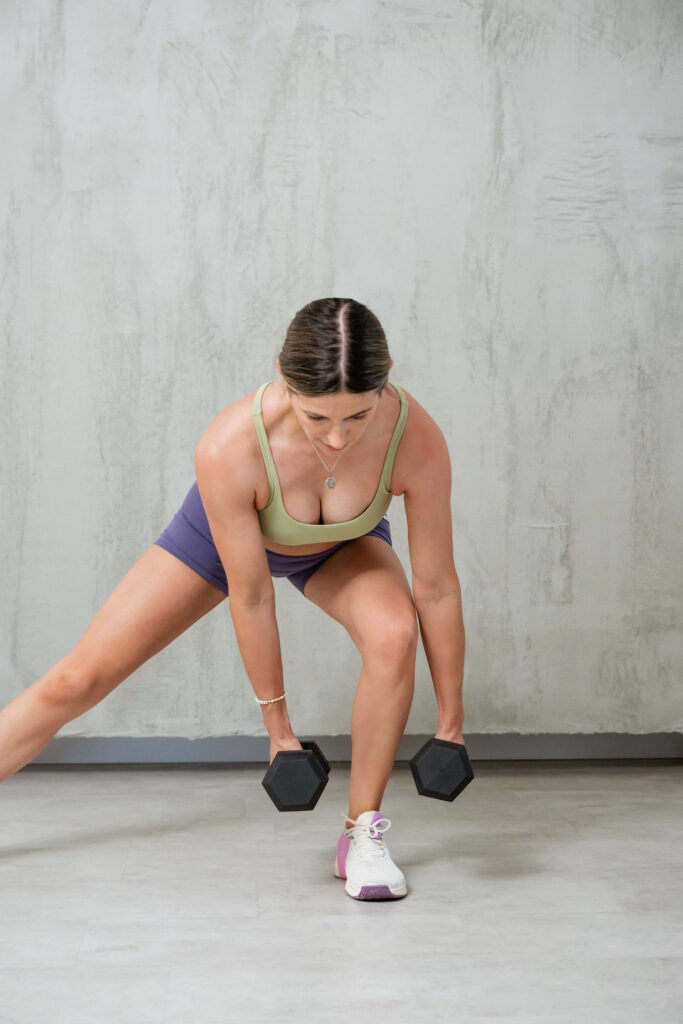
Pregnancy will cause a loss of strength and tone, regardless of whether you end up having a vaginal or cesarean birth or symptoms of a pelvic floor dysfunction.
Kegels alone do not build a strong system. The pelvic floor does not work in isolation, so why train it that way? The pelvic floor, similar to other muscles in our body, has a range of motion that it moves through for optimal function. The pelvic floor can:
- Lengthen (eccentrically loading)
- Relax (midrange position, able to respond to demand in any direction)
- Shorten (concentric activation).
Along with be able to squeeze and lift (the contraction), relax and lengthen, you need to be able to squeeze and relax quickly (fast and slow twitch muscle fibers) and hold for 10 seconds (endurance). It needs to be able to fire and relax quickly as well as sustain the stress of a hard workout, or even a cough/sneeze.
A hypertonic pelvic floor is a tight pelvic floor with a reduced capacity to relax. The extra weight from pregnancy can cause the muscles to become overactive and tight. Many people with a tense and non-relaxing pelvic floor experience pelvic health concerns such as constipation, painful sex, urgency, tailbone and pelvic pain. A hypertonic pelvic floor may also be accompanied by tension in surrounding hip and pelvic muscles.
A hypotonic pelvic floor is where the pelvic floor muscles are too long and weak, and may not be adequately supporting the pelvic organs. Most often the cause of this comes after childbirth (trauma, pushing for a long time etc) but can also happen from the extra weight of carrying your baby coupled with ligament laxity. Pelvic floor physical therapy can improve the strength and tone of the pelvic floor muscles. Common symptoms of a hypotonic pelvic floor include: pelvic organ prolapse, urinary or fecal incontinence, passing gas when bending or lifting, decreased sensation during sex, pain or pressure in the pelvis and feeling like something is bulging or falling out of your vagina.
It’s also possible to have both a tight and weak pelvic floor. You are likely going to see this in postpartum women who have had a vaginal birth, tearing/episotomy,forseps. The scar tissue with cause it to tighten as it heals and then the pelvic floor is weaker from expanding 2-3x times its original size during a vaginal birth.
So why aren’t isolated kegels necessarily right for you?
Picture this.. you’re doing a bicep curl from full elbow extension to full elbow flexion, you can generate a lot of force and build strength in this range. Now imagine doing bicep curls when your elbow can’t extend past a 90 degree bend. You’re not going to build strength through such a limited range of motion and in fact you’ll likely only make that short muscle even tighter. And this applies to your pelvic floor. Instead of working it’s full range of motion, you are walking around all day never really relaxing your pelvic floor. Then you add a Kegel on top of that, without ever really getting that relaxation and length to your pelvic floor. Often, all they are doing is making a tight pelvic floor, tighter. A weak pelvic floor, weaker.
There may be a time and a place for kegels, but that is something a physical therapist would prescribe their clients after an internal exam. And from personal experience, I have always seem them use other interventions before prescribing that.
Exercises that have more muscle recruitment than an isolated kegel:
- Bridges- 56% more effective
- All fours hovering- 49% more effective
- Lunge- 42% more effective
- Cat Cow – 41% more effective
- Squat- 30% more effective
- Clamshells- 25% more effective
Study taken from AJOG by Crawford et al. “Each of the movements produced a mean statistically significant increase in PF activity than traditional (stationary) Kegel exercises. Specialized movements, when performed in conjunction with voluntary pelvic floor contractions may provide greater motor unit recruitment than traditional Kegel exercises. Individuals vary as to the degree of enhanced engagement with any given movement.“
Approaches to building pelvic floor strength, instead of isolated kegels
- 360 breathing: Coordinating the diaphragm and pelvic floor;
- Awareness of posture and alignment: Things like glute clenching, sticking your butt out, ab gripping, forward head posture are all things that can increase dysfunction symptoms. Women who clench their glutes are likely going to have a tight pelvic floor. The glutes work hand in hand with the pelvic floor and core and pelvic floor weakness can result in clenching, excessive gripping, tucking under as compensation to create stability. Rather than strength, you’re creating both tension and weakness.
- Deep core strength: I like to add a pilates ball during pregnancy and especially during the first few months postpartum to help cue the pelvic floor, adductors and deep core.
- Mid Back mobility: You need your rib cage to move in all directions to manage pressure and get that full breath.
- Glute Strength and single leg strength: Your glutes are BFFs with your pelvic floor. If they are not strong, your pelvic floor will pick up the slack. Which ties back in with the glute clenching, mentioned above.
It is important to be able to target the pelvic floor, but I do not recommend doing 500 kegels a day. Instead try these exercises that activate your pelvic floor muscles and build functional strength.
I’m deeply passionate about helping women feel strong, informed, and confident through every stage of motherhood. You deserve more than just a list of do’s and don’ts or generic modifications. With years of hands-on coaching across all kinds of athletes and clients, I blend real-world experience with specialized pre and postnatal knowledge to create strength programs that go far beyond basic adjustments. This is high-level, accessible training - built for your body, your season, and your goals
EXPLORE MORE POSTS